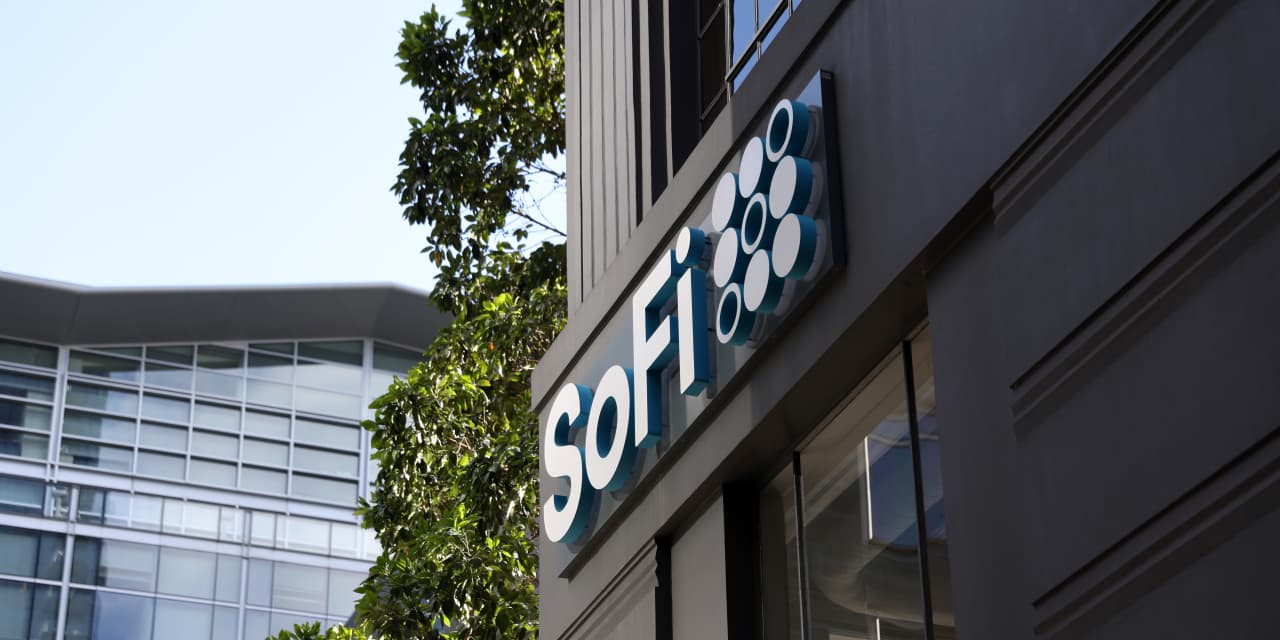The fintech is set to drop its third-quarter earnings on Monday before the market opens. Investors will be looking for signs that SoFi (ticker: SOFI) has what it takes to carve a space in this competitive industry now that a pandemic-related challenge to the business has passed.
The company began as a lender focused on refinancing student debt, but now operates through three segments: lending, which includes student, personal, and home loans; financial services; and a technology platform.
On Monday, investors will be watching the student-loan business, which took a beating while people who owed money on those loans were allowed to stop making payments as the advent of Covid-19 rattled the economy. Now, with the pause lifted this month after more than three years, backers of the stock are ready to see those numbers tick back up.
The repayment pause was lifted at the beginning of October, while SoFi’s third quarter ended Sept. 30, but analysts say the company may already be benefiting. Analysts surveyed by FactSet have penciled in $651.5 million in third-quarter student-loan origination volume, soaring past both the $395.4 million recorded the prior quarter and the $457.2 million in the year-earlier quarter.
“I would expect several student loan borrowers to proactively look to lower their payments ahead of the October payment re-start,”
Piper Sandler
analyst Kevin Barker, who rates the shares at Neutral, told Barron’s via email Friday.
J.P. Morgan
analysts Reginald Smith and Charles Pearce, who also rate the shares at Neutral, shared a different perspective. They expect third-quarter student-loan originations to decline 18% from a year earlier, writing in a Thursday report that they “believe the bulk of student loan refinance opportunity is still a few quarters away.”
Analysts are estimating $3.61 billion in third-quarter personal loan originations and $245.3 million in home loans, compared with $3.74 billion and $243.1 million notched in the second quarter, respectively.
Also top of mind is whether SoFi is making strides toward profitability, which management says it is hoping to achieve by the fourth quarter. Analysts are slightly less optimistic, calling for a loss of 8 cents a share in the third quarter. They say SoFi is likely to break even in the first quarter of next year.
Management has been feeling quite confident. Earlier this year, SoFi Chief Executive Officer Anthony Noto told Barron’s that it is just a matter of time before his company becomes one of the country’s top 10 financial firms. The numbers say there is a long way to go.
With a market capitalization of $6.6 billion, SoFi is dwarfed by companies like
JP Morgan Chase
(JPM),
Bank of America
(BAC), and
Wells Fargo
(WFC). They boast market caps of about $409 billion, $208 billion, and $145 billion, respectively.
That makes vaulting into the top 10 a lofty goal. It may be complicated by the company’s focus on a core target customer: people whose average income is $100,000 or higher.
“Our products are going to appeal to more than our core target; they already have,” the CEO told Barron’s earlier this year. “But like most great brands that cross over, if we build a great product for one core group, it will increasingly meet the needs of other core groups.”
Focusing on relatively wealthy people may reduce credit losses because such clients have more in their wallets, but it could also limit the market SoFi can address. That might eventually make it harder to snap up new customers, a critical driver of growth and profitability for banks.
That being said, SoFi has certainly gotten analysts’ attention. Truist Securities analyst Andrew Jeffrey hailed it as “the future of U.S. banking: digital, nimble and always on,” earlier this year. Competitors include
LendingClub
(LC),
Rocket
(RKT),
UpStart
(UPST), and
Marqeta
(MQ), according to Piper Sandler’s Barker.
Mizuho analyst Dan Dolev, who rates shares at Buy, is upbeat on SoFi. “Longer term investors are worried that an online bank isn’t a good business model, which we vehemently disagree with,” he told Barron’s in an email. “They are seeing very strong deposit inflows, which is the key.”
Overall, however, analysts are less upbeat on SoFi this year. Only 32% rate it at Buy, compared with 56% in April, according to FactSet.
The stock has had a stellar year, with a gain of 49%. Though it is trading far below its level when it began to be publicly traded, it is faring much better than other fintechs in the face of rising interest rates.
PayPal Holdings
(PYPL) is down 29% this year, while
Block
(SQ) is 36% lower.
SoFi was founded in 2011 and taken public on June 1, 2021, through the special purpose acquisition company Social Capital. Shares opened at $21.97 and closed at $22.65 that day, according to Dow Jones Market Data. Since then, shares have tumbled, ending Friday at $6.87.
Piper Sandler’s Barker offered some ways the stock could see a significant push higher.
“A drop in interest rates will be a big boost to SOFI as it would lead to more demand for the lending products while lowering their deposit costs,” Barker told Barron’s via email. Continuing to snap up additional clients within its tech platform would also lift that segment’s valuation, he added.
J.P. Morgan’s Smith and Pearce also chimed in on what could raise the stock. “We think shares are poised for a rally on the print on EBITDA upside, encouraging commentary around GAAP profitability and solid KPIs trends, which should stand in contrast to many of SoFi’s fintech and payment peers,” they wrote in their Thursday report.
SoFi has already offered investors a show. The next act starts now.
Write to Emily Dattilo at emily.dattilo@dowjones.com
Read the full article here













Leave a Reply